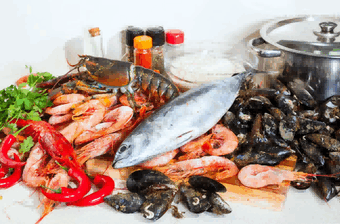 Import News
Import News
 2023-09-11
2023-09-11
The global seafood industry is a vast ocean of flavors, varieties, and business opportunities. As seafood importers play a pivotal role in bringing these treasures from the sea to our plates, it's intriguing to explore the preferences and trends that shape their choices. In this article, Tendata will dive into the world of seafood imports and discover which aquatic products are favored by seafood importers.
>>>Click to Request A Free Demo - Quick Find Potential Customers<<<

Introduction: The Bounty of the Seas
Seafood is a delicacy cherished worldwide, renowned for its nutritional value and diverse tastes. The United States, for instance, is a significant player in the seafood industry, importing a wide range of aquatic products to meet consumer demand. This industry is characterized by its dynamic nature, influenced by factors such as consumer tastes, sustainability concerns, and international trade dynamics.
Key Aquatic Products Favored by Seafood Importers
Seafood importers cast their nets wide to bring in a diverse array of aquatic products. Here are some key players that find favor among seafood importers:
· Shrimp:
Shrimp is one of the most popular seafood items in the United States. Its versatility, mild flavor, and wide range of culinary applications make it a favorite among seafood importers. Countries like India, Indonesia, and Ecuador are major sources of shrimp imports.
· Salmon:
Salmon, known for its rich flavor and high Omega-3 content, is a sought-after product. Wild-caught Alaskan salmon and farmed Atlantic salmon are both in demand. Importers pay close attention to sourcing practices to ensure sustainability.
· Tuna:
Tuna, particularly yellowfin and albacore, is prized for its use in sushi and sashimi. Countries like Thailand and the Philippines are significant sources of tuna imports. Importers often prioritize quality and traceability.
· Cod:
Cod is a staple in many traditional dishes, especially in the Northeastern United States. Iceland and Norway are notable sources of cod imports. Importers value the flaky texture and mild flavor of cod.
· Lobster:
Lobster, known for its succulent meat, is a delicacy often associated with special occasions. The United States, particularly Maine, is renowned for its lobster. Importers focus on the freshness and size of lobsters.
Trends and Insights: What Drives Seafood Imports
Several factors influence the choices of seafood importers:
· Consumer Health Awareness: Health-conscious consumers are seeking seafood for its nutritional benefits. This drives the import of species like salmon, known for its Omega-3 content.
· Sustainability: Sustainability is a growing concern. Importers are increasingly sourcing seafood that adheres to responsible fishing practices and environmental standards.
· Cultural Influences: Cultural factors play a role in seafood preferences. For example, sushi's popularity fuels the demand for tuna and other sushi-grade fish.
· Restaurant and Foodservice Demand: The restaurant industry heavily influences seafood imports. High-end dining establishments often demand premium seafood products.
· Trade Agreements and Regulations: Trade agreements and regulations impact the availability and cost of seafood imports. Importers navigate these complexities to ensure a consistent supply.
The Future of Seafood Imports: Navigating Challenges and Opportunities
The seafood import industry is not without its challenges, including overfishing concerns, supply chain disruptions, and regulatory changes. However, it also holds immense opportunities as consumers continue to embrace seafood as a healthy and delicious dietary choice. Seafood importers will play a pivotal role in meeting this demand while ensuring sustainability and quality.
Conclusion: A World of Seafood Awaits
Seafood importers are the bridge between the ocean's bounty and consumers' plates. The diverse range of aquatic products they source reflects the richness of the seas and the evolving tastes of consumers. As the industry continues to evolve, it promises an exciting voyage filled with flavors, traditions, and opportunities for all who participate.
Another News
Latest News Released Today: Tendata Blogs
Other Trade Data References to Seafood:
1. Exploring New Supplier Opportunities in the Wake of China's Ban Import Seafood from Japan
2. What Seafood Does China Import?
3. Are There Any Specific Certifications That Frozen Seafood Importers Look For?
4. China Bans Imports of Japanese Seafood Due to Nuclear Effluent Discharge from Japan
5. Russia Hopes to Increase Fish and Seafood Exports to China after Japan Ban
Category
Leave Message for Demo Request or Questions


 T-info
T-info T-discovery
T-discovery

 My
Tendata
My
Tendata Market Analysis
Market Analysis Customer
Development
Customer
Development Competitor
Monitoring
Competitor
Monitoring Customer Relationship
Customer Relationship





































































































































